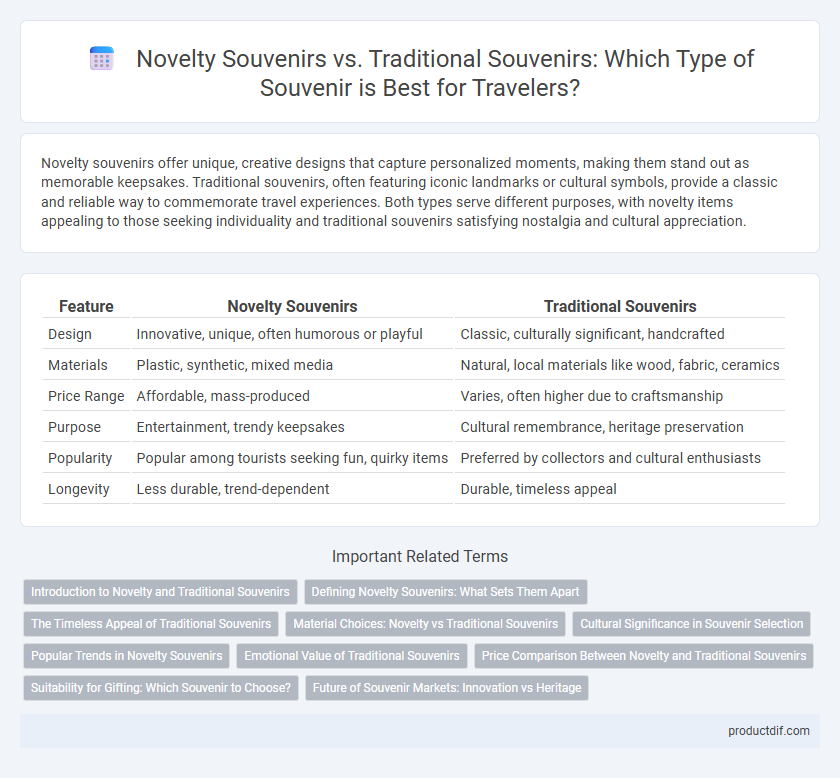Novelty souvenirs offer unique, creative designs that capture personalized moments, making them stand out as memorable keepsakes. Traditional souvenirs, often featuring iconic landmarks or cultural symbols, provide a classic and reliable way to commemorate travel experiences. Both types serve different purposes, with novelty items appealing to those seeking individuality and traditional souvenirs satisfying nostalgia and cultural appreciation.
Table of Comparison
| Feature | Novelty Souvenirs | Traditional Souvenirs |
|---|---|---|
| Design | Innovative, unique, often humorous or playful | Classic, culturally significant, handcrafted |
| Materials | Plastic, synthetic, mixed media | Natural, local materials like wood, fabric, ceramics |
| Price Range | Affordable, mass-produced | Varies, often higher due to craftsmanship |
| Purpose | Entertainment, trendy keepsakes | Cultural remembrance, heritage preservation |
| Popularity | Popular among tourists seeking fun, quirky items | Preferred by collectors and cultural enthusiasts |
| Longevity | Less durable, trend-dependent | Durable, timeless appeal |
Introduction to Novelty and Traditional Souvenirs
Novelty souvenirs often feature unique, humorous, or contemporary designs that appeal to modern trends and personal expressions, making them popular among younger travelers seeking distinctive keepsakes. Traditional souvenirs typically embody cultural heritage and local craftsmanship, such as handmade textiles, pottery, or iconic symbols, preserving the essence of the destination's history. Both types of souvenirs offer valuable mementos, but novelty souvenirs highlight creativity and innovation, whereas traditional souvenirs emphasize authenticity and cultural significance.
Defining Novelty Souvenirs: What Sets Them Apart
Novelty souvenirs distinguish themselves from traditional souvenirs through their unique, often humorous or quirky designs that appeal to contemporary tastes and trends. They prioritize creativity and personalization, offering items like customized apparel, pop culture-themed trinkets, or limited-edition collectibles that reflect current interests. Unlike conventional souvenirs, which typically emphasize cultural heritage or iconic landmarks, novelty souvenirs focus on delivering memorable, fun experiences that resonate with individual personalities.
The Timeless Appeal of Traditional Souvenirs
Traditional souvenirs embody cultural heritage through artisanal craftsmanship and authentic materials, preserving stories and memories tied to specific destinations. Their timeless appeal lies in the emotional connection they foster, offering a tangible link to history and local customs. Collectors and travelers often cherish these items for their uniqueness and enduring significance, far beyond mere novelty.
Material Choices: Novelty vs Traditional Souvenirs
Novelty souvenirs often utilize lightweight, synthetic materials such as plastic, resin, or silicone to create vibrant, eye-catching designs that emphasize creativity and modern trends. In contrast, traditional souvenirs typically feature natural, durable materials like wood, ceramics, and textiles, highlighting cultural heritage and artisanal craftsmanship. The choice of materials fundamentally influences the souvenir's aesthetic appeal, longevity, and connection to the place of origin.
Cultural Significance in Souvenir Selection
Novelty souvenirs often serve as playful mementos, capturing a moment or trend rather than deep cultural meaning, whereas traditional souvenirs embody the heritage and customs unique to a destination. Selecting souvenirs with authentic cultural significance fosters a meaningful connection to the local history, art, and traditions of the place visited. Travelers seeking to preserve cultural identity prioritize items like handcrafted textiles, indigenous artwork, or locally produced artifacts over mass-produced novelty goods.
Popular Trends in Novelty Souvenirs
Novelty souvenirs are gaining popularity due to their unique designs, interactive features, and personalized options, appealing especially to younger travelers seeking memorable keepsakes. Popular trends include augmented reality postcards, eco-friendly materials, and customizable 3D-printed collectibles that offer a modern twist compared to traditional magnets, keychains, and postcards. This shift reflects a growing demand for innovative, sustainable, and personalized mementos that enhance the travel experience beyond conventional souvenirs.
Emotional Value of Traditional Souvenirs
Traditional souvenirs often carry deep emotional value by preserving memories and cultural heritage through tangible connections to a place or event. Handmade crafts, local artifacts, and time-honored keepsakes evoke nostalgia and personal significance, enriching the travel experience beyond mere aesthetics. These sentimental attachments contrast with novelty souvenirs, which prioritize uniqueness or humor over meaningful storytelling.
Price Comparison Between Novelty and Traditional Souvenirs
Novelty souvenirs typically cost less due to mass production and use of inexpensive materials, while traditional souvenirs often command higher prices because of handcrafted quality and cultural significance. Price comparisons reveal that novelty items attract budget-conscious travelers, whereas traditional souvenirs appeal to those willing to invest in authentic keepsakes. Retailers balance pricing strategies to cater to different consumer preferences within tourist markets.
Suitability for Gifting: Which Souvenir to Choose?
Novelty souvenirs offer unique, creative designs that appeal to recipients seeking playful or unconventional gifts, making them ideal for casual or lighthearted occasions. Traditional souvenirs, often featuring cultural or historical significance, provide meaningful and timeless keepsakes that resonate well with recipients valuing heritage and authenticity. Choosing between novelty and traditional souvenirs depends on the recipient's personality and the context of the gifting occasion, ensuring the gift reflects thoughtfulness and relevance.
Future of Souvenir Markets: Innovation vs Heritage
Novelty souvenirs, driven by innovation and modern design, capture current trends and appeal to tech-savvy travelers seeking unique, personalized mementos. Traditional souvenirs emphasize heritage and craftsmanship, preserving cultural identity and historical significance through timeless artisan methods. The future of souvenir markets hinges on balancing cutting-edge creativity with the preservation of cultural authenticity to meet diverse consumer preferences.
Novelty Souvenirs vs Traditional Souvenirs Infographic

 productdif.com
productdif.com